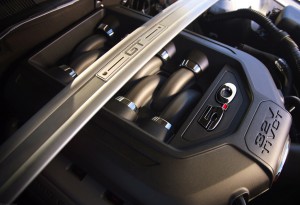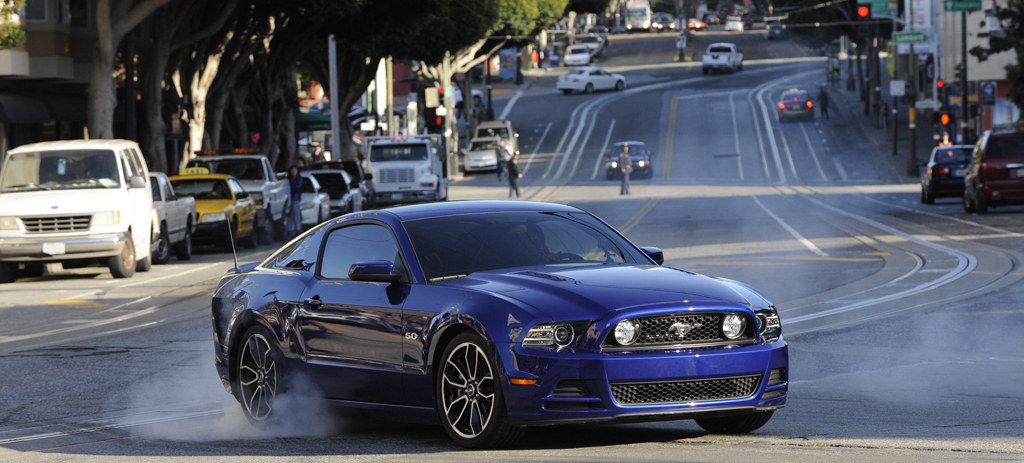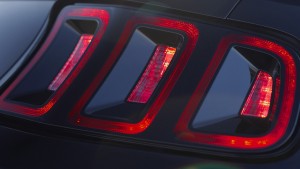
Is it possible the great American V-8 muscle car is entering its final act? For 2013, Ford increased the horsepower from 412 to 420. Other changes include a pair of heat extractor vents in the hood.
Sitting at a traffic light, we wait for the light to turn green, a Ford Focus driver sits nonchalantly in the next lane. When the light turns, we dump the clutch, floor the throttle … and hang on, tires squealing, head slammed against the leather Recaro bucket seat. The Focus disappears in the rearview mirror.
Has it even started moving yet?
There’s nothing quite like the sound and fury of an American V-8 at full brew.
When historians look back on the story of cars some distant day in the future, they may well look at the mid 20-teens as the zenith of the muscle car. Forget the ’60s when most people thought the muscle cars were fast. Today’s fast cars are simply more powerful and better designed. They’re lighter and modern developments affecting everything from tires to electronic features make them easier to drive and put the power where it can do the most good – on the pavement. They’re even more fuel efficient.
And they’re still dirt cheap. For a little more than $31,000, you can walk into any Ford dealer and walk out with a 420-horsepower Mustang similar to this one that is simply scary fast. The story is similar at the local Dodge or Chevy dealer where salesmen will be happy to show you their similarly powerful Pony Car entries, the Challenger and Camaro.
And they could be some of the last of their kind ever to spin their tires.
That’s because new regulations taking effect gradually over the next 13 years will raise fuel economy standards to 54.5 mpg by 2025. That figure is a fleet average, so fuel-efficient Focuses and Fiestas will counter the guzzlers, and the EPA’s convoluted formula for figuring a car’s corporate average fuel economy number make it sound worse than it is. But the question must be asked: Can Ford afford to make a 420-horsepower, V-8-powered coupe like the current Mustang? Will Ford be able to justify building a car that imparts such a big hit on its overall CAFE number?

For 2013, the Ford Mustang GT features a more aggressive front fascia with standard HID headlights and LED accent lights.
The answer might be that big horsepower will equate to big money. Automakers already do that to some degree. While Ford used to offer the V-8 in the otherwise base Mustang, it currently requires you to step up and buy the GT with all its fancy features, thus allowing it to justify a significantly higher price tag. That eliminates some of the pretenders who dream about owning a V-8-powered Mustang, but find it just a little out of their reach. They settle for the V-6-powered car, still a significant performance car in its own right, and just drool whenever they see – and hear – the GT leave them in the dust at a traffic light.
The GT isn’t even the most powerful Mustang, not by a longshot. Ford partners with Shelby American on the GT500, which adds a V-6 worth of power to that of the regular V-8. With 662 horsepower, the Shelby is the most powerful production V-8 in the world, and is the most insane performance bargain on the market starting at $55,000. And just in case that still isn’t enough power, Shelby will make a very limited number of Super Snakes with an optional upgrade to 850 horsepower. Why? Doesn’t everyone need an 850-horsepower car that can barely seat four people?
Ford will most likely continue offering a V-8-powered GT for the next generation and maybe even the next generation after that. But after the early 2020s, all bets are off.
Here’s a scenario of what a 2023 Mustang might look like under the hood:
The four cylinder in the Mustang – likely added for the 2014 model year – continues to get smaller. For the base engine, it’s a 1.3-liter turbo, pumping out 220 horses. An electric motor assists the gas engine and regenerative brakes capture otherwise lost energy and store it in the latest hybrid battery. In fact, electric motors are now a part of 90 percent of the powertrain options Ford offers in all its cars.
The top engine in the Mustang GT is a twin-turbo 2.0-liter four cylinder making 325 horsepower. The car is smaller and high-tech materials such as carbon fiber and lots aluminum reduce weight, allowing the coupe to make the best use of less power.
As for the V-8, you can still get one, but only in the Shelby. The new V-8 is reduced to 3.5 liters and with twin turbos, it makes 550 horsepower. Compared to the current Shelby, its higher price is justified by more standard equipment.
In other words, the automaker will price more buyers out of the V-8, reserving it for a precious few who can afford the higher price of admission.
Of course, this is just conjecture. Maybe Ford can sell enough Fiestas and Focuses to allow it to continue the traditional Mustang formula: small coupe, oversize V-8 engine, big power, low price. But more than likely, the days of the traditional American muscle car and its gaudy V-8 are numbered.
Earlier this month, Chrysler Group CEO Sergio Marchionne, never one to mince words, said the V-8 would become “as rare as white flies.” He outta know.
It might make sense to buy one of the current crop of Mustangs and park it in the garage so that 20 years from now, you can dust it off and take it out to the Woodward Dream Cruise to blow the doors off some envious guy in his 2033 four cylinder Mustang GT. After tearing up the pavement, park it, prop the hood open and let the jealous spectators drool over the All-American automotive sculpture hidden beneath.

